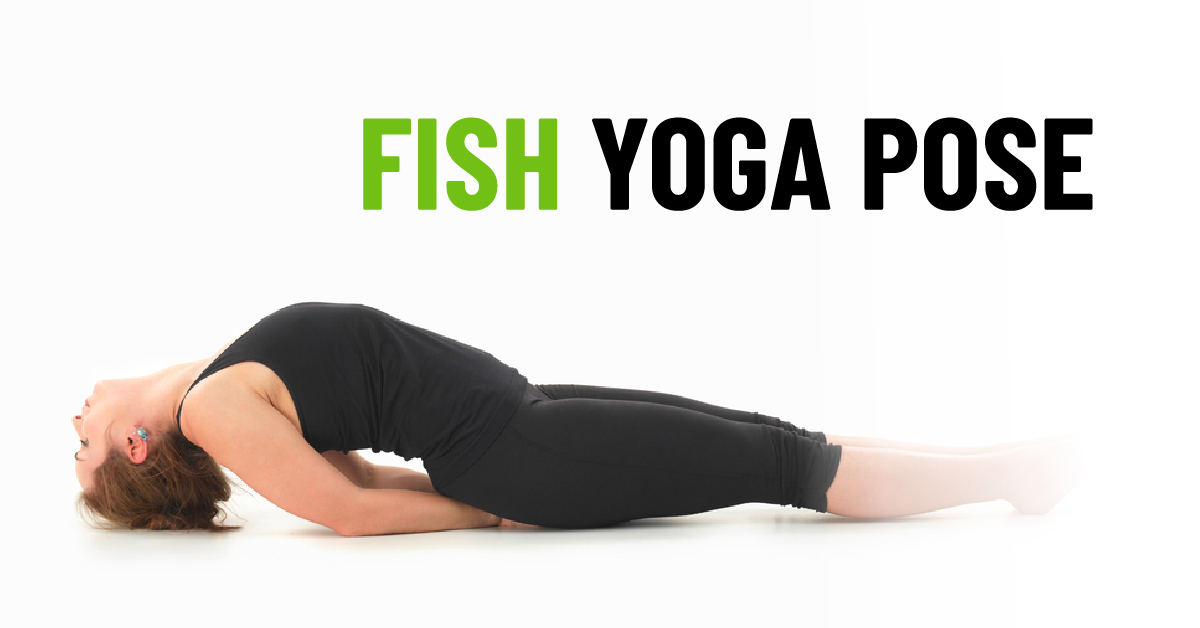How To Do Fish Yoga Pose

Also available in
Yoga is a wonderful form of fitness that has been performed for many years. It is an ancient practice that helps to balance the body, mind, and soul. The fish yoga pose is also known as Matsyasana. It is one of the most popular yoga poses that can help you relax and rejuvenate. It is a beginner-level pose that can be practiced by anyone, regardless of their age or fitness level.
Here we will take a deep dive into the world of the fish yoga pose and explore its benefits, modifications, variations, precautions, and how to perform the pose.
How to Perform the Fish Pose?
The fish yoga pose is a simple yet effective posture that can be performed in a few easy steps.
Here’s how to do Fish Pose:
- Lie flat on your back with your legs extended and arms by your side.
- Place your palms underneath your buttocks with your elbows close to your body.
- Inhale and lift your chest up, arching your back.
- Keep your head on the floor and hold the posture for a few deep breaths.
- Exhale and release the posture by lowering your chest and head back to the floor.
Tips for Practicing the Fish Yoga Pose
- It is important to warm up your body before practicing the fish yoga pose to avoid any muscle strain or injury. You can do some gentle stretches or a few rounds of sun salutations to prepare your body.
- If you feel uncomfortable in the pose or have limited flexibility, you can use a yoga block or bolster to support your back. This will help you maintain the posture for a longer period of time.
- To activate the muscles in your legs and maintain balance, keep your feet flexed and engaged. This will also help you stay grounded and stable in the pose.
- As you hold the pose, try to relax your facial muscles and release any tension in your jaw or forehead. Focus on your breath and allow your mind to calm down.
Benefits of Fish Pose
The fish yoga pose has several benefits for the mind and body. The most noticeable advantages of doing this pose are listed below:
Stretches the chest and neck: The fish pose opens up the chest and stretches the muscles in the neck and shoulders. This can help improve posture and reduce tension in the upper body.
Stimulates the thyroid gland: The stretch in the neck and throat area stimulates the thyroid gland, which can help regulate metabolism and boost energy levels.
Relieves stress and anxiety: Deep breathing and relaxation in the pose can help calm the mind and reduce stress and anxiety.
Improves digestion: The fish pose can help stimulate the digestive organs and improve digestion.
Reduces fatigue and insomnia: The pose can help reduce fatigue and insomnia by improving blood circulation and reducing tension in the body.
Increases flexibility: The stretch in the chest, neck, and spine can improve overall flexibility and mobility.
Opens up the heart center: The fish pose can help open up the heart center, promoting feelings of love, compassion, and forgiveness.
Fish Pose Modifications
While the fish pose is a relatively simple yoga posture. There are several modifications you can make to tailor it to your needs and abilities. Here are some common modifications for the fish yoga pose:
1. Use props for support: If you have limited flexibility in your spine or find it difficult to keep your chest lifted, you can place a yoga block or bolster underneath your upper back for support.
2. Modify leg position: To make the pose more accessible, you can keep your legs bent with the soles of your feet on the mat. Alternatively, you can straighten your legs and keep them together if you have more flexibility.
3. Adjust arm placement: If you have shoulder pain or discomfort, you can place your hands underneath your hips with your palms facing down. You can also place your hands on your thighs or interlace your fingers behind your back.
4. Practice with a partner: For a deeper stretch, you can practice the fish yoga pose with a partner. Have your partner sit behind you and gently pull your upper back towards them to deepen the stretch.
5. Use a chair: If sitting on the floor is uncomfortable for you, you can sit on a chair with a firm back and perform the fish pose with the support of the chair.
Fish Pose Variations
The fish pose is a versatile yoga posture that can be modified and varied in many ways to suit different needs and abilities. Here are some variations of the fish yoga pose you can try:
1. One-legged fish pose: This variation involves extending one leg straight out while keeping the other leg bent. This helps deepen the stretch in the chest and shoulders and challenges your balance.
2. Bound fish pose: In this variation, you bring your hands together behind your back and interlace your fingers. Then, lift your chest and press your hands towards the floor to deepen the stretch in the chest and shoulders.
3. Supported fish pose: If you have limited flexibility in your spine or find it difficult to maintain the posture for a long time, you can use a yoga block or bolster to support your back. Place the prop underneath your upper back and rest your head on the mat for a more restorative variation.
4. Reverse prayer fish pose: This variation involves bringing your palms together behind your back with your fingers pointing down. Lift your chest and press your palms towards each other to deepen the stretch in the chest and shoulders.
5. Lotus fish pose: For a more challenging variation, sit in the lotus pose and perform the fish yoga pose. This helps open up the hips and stretches the chest and shoulders.
These variations can help you deepen your practice, challenge your balance, and improve your flexibility and mobility.
Precautions for Practicing Fish Yoga Pose
- Avoid the pose if you have neck injuries or neck pain: The fish yoga pose involves lifting the head and arching the neck, which can exacerbate neck injuries or pain. If you have any neck issues, it is best to skip the fish pose or modify it with props for support.
- Take care if you have low back pain: While the fish pose can help alleviate low back pain, it is important to approach the posture with caution if you have an acute or chronic low back condition. You may want to modify the pose with props or skip it altogether if it causes discomfort or pain.
- Listen to your body: As with any yoga posture, it is important to listen to your body and only do what feels safe and comfortable for you. Do not force the stretch or push yourself beyond your limits.
- Avoid the pose during menstruation: Some yoga traditions suggest avoiding inversions and backbends during menstruation, including the fish pose. You can skip the fish pose during your period or modify it with a supported variation.
- Practice under the guidance of a qualified teacher: If you are new to yoga or have any concerns about practicing the fish pose, it is always a good idea to seek the guidance of a qualified yoga teacher who can help you modify the posture and ensure you are practicing safely.
CONCLUSION
The fish yoga pose is a simple yet powerful posture that can provide deep relaxation to your mind and body. It is a great pose to practice at the end of a long day or after a strenuous workout.
By following the tips, precautions, and steps outlined in this guide, you can perform the pose safely and effectively.
Frequently Asked Questions (FAQs)
How long should you hold a fish pose?
The length of time you should hold a fish yoga pose can vary depending on your comfort level and experience with the pose. As a general guideline, you can start by holding the pose for 15-30 seconds, gradually increasing the duration as you become more comfortable and confident with the posture.
What area does fish pose target?
The fish pose primarily targets the upper body, specifically the chest, shoulders, and neck. The pose opens up the chest, creating more space for the lungs to expand and improving overall breathing capacity. It also stretches the shoulders and neck, helping to alleviate tension and discomfort in these areas. Additionally, the pose can stimulate the thyroid gland and regulate metabolism, providing benefits for the entire body.
Who should not do fish pose yoga?
People with neck or lower back injuries and pregnant women should avoid or modify the fish pose yoga. It is best to consult with a qualified yoga teacher before attempting the pose.
More Yoga :
- 5 Most Effective Face Yoga for Double Chin
- 5 (five) Yoga for Digestion – Can Yoga help to improve Digestion?
- Sexual Yoga poses to get Better at Sex
- BFF 2 Person Yoga Poses for Build a Strong Connection
- Yoga for Sciatica Pain Relief and Prevention
- Happy Baby Yoga Pose | How To Do, Benefits, Modification and Precaution
- How To Practice Half Moon Pose (Ardha Chandrasana)






